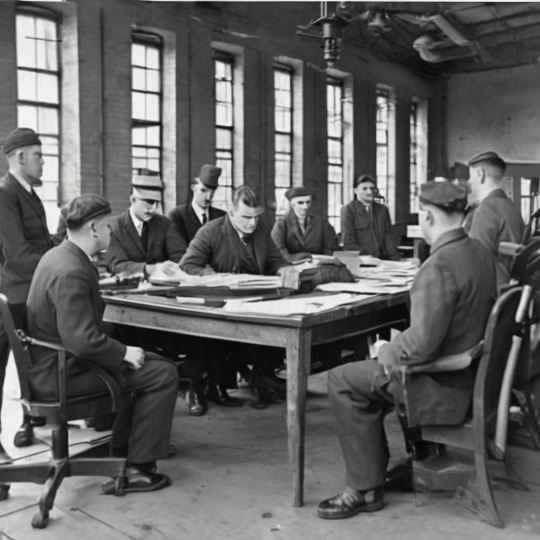#ComparativeDevelopment
Explore tagged Tumblr posts
Text
The Development of Personnel Management and Industrial Relations: A Historical Perspective

The fields of personnel management and industrial relations have undergone considerable evolution, influenced by social, economic, and political factors across various countries. A comparative look at the United Kingdom and the United States provides insight into the development of these disciplines from a historical perspective, with differences that reflect each country’s approach to labor and management.
The Role of Personnel Management in Britain
In Britain, personnel management developed as a field distinct from industrial relations, with a greater focus on human resources and labor management within organizations. Early attention to personnel management in Britain is often attributed to the efforts of organizations like the Chartered Institute of Personnel and Development (CIPD). Originally known as the Chartered Institute of Personnel and Development (CIPD), this institution was established to professionalize and formalize the practice of personnel management, emphasizing skills in managing and developing staff.
British universities, compared to other European nations, invested significantly in research and teaching related to human relations and industrial relations, with relatively limited focus on labor law. This reflects the British context, where employment regulations were traditionally light and less reliant on legal frameworks. Industrial relations in Britain, therefore, were often focused on labor-management relations, specifically in terms of union relationships and collective bargaining. However, as noted by Gospel (1992), beginning in the mid-1960s, there was a shift in focus, with increasing attention on management practices. This shift coincided with growing complexities in labor relations and the need for more refined approaches to managing human resources within organizations.
Human Relations and Industrial Relations in the United States
In contrast, the United States experienced a boom in human resources management (HRM) broadly defined during the period from 1945 to 1965, while personnel management itself remained relatively stagnant. The term "industrial relations" in America continued to be applied broadly, encompassing all facets of employment, including personnel. As the country emerged from World War II, the spread of unionism spurred the establishment of numerous industrial relations centers and institutes at universities, many of which had been absent before the war. Kaufman (2004) highlights that the impetus for these programs was primarily the rapid expansion of unions and the ensuing challenges around collective bargaining, dispute resolution, and contract administration.
Furthermore, industrial relations in the U.S. saw a rise in interest around human relations within industry, driven by an understanding that the well-being of employees significantly influenced organizational outcomes. With the focus on management and organizational design, many American universities began exploring human relations principles to foster a healthier work environment and improve productivity. The expansion of industrial relations programs in this period reflected a broader acknowledgment of the importance of employee welfare and workplace harmony.
Comparative Development and Contemporary Implications
The historical context of personnel management and industrial relations in both Britain and the United States provides a foundation for understanding contemporary human resources practices. Britain’s approach, rooted in managing union relations and emphasizing limited legal intervention, contrasts with the broader American view of industrial relations as encompassing all aspects of employment. This divergence reflects the unique labor histories and economic policies in each country and continues to influence contemporary HRM practices and policies.
Overall, the development of personnel management and industrial relations underscores the dynamic nature of labor and employment practices. As organizations continue to adapt to changing economic and social landscapes, the historical insights from Britain and the United States remain valuable in shaping effective human resources strategies today.
Unseen Influences: The Evolution of Personnel Management and Industrial Relations in Britain and the United States

One lesser-known influence on the evolution of industrial relations and personnel management was the impact of social changes, especially in the post-war period. In both Britain and the United States, societal shifts — such as the civil rights movement, the growing role of women in the workforce, and changing attitudes towards work-life balance — influenced the development of HR practices. Companies began to adopt policies that recognized diversity and inclusion, though these were initially seen as progressive changes rather than standard practices. Over time, however, these movements began to reshape HR policies and company cultures, laying the groundwork for what would eventually become core elements of modern personnel management.
Similarly, technological advancements brought new challenges and opportunities to personnel management. The introduction of computers and automation in the workplace during the mid-20th century changed the nature of jobs, influencing workforce demands and reshaping traditional roles. Management had to adapt by developing strategies for retraining employees, managing redundancies, and addressing fears around job security. These shifts underscored the need for personnel management to evolve and respond not only to economic and political factors but also to the fast-paced changes in technology and society.
A Broader Perspective on Industrial Relations
In Britain, industrial relations traditionally focused on union and labor relations, yet there were broader aspects tied to economic and political frameworks that shaped the scope of these relations. For instance, during the economic struggles of the 1970s, Britain’s labor market faced significant pressures, which led to widespread strikes and industrial action. These events forced both businesses and the government to consider more robust HR policies and labor relations frameworks to manage worker dissatisfaction and improve productivity. However, these policies were often seen as reactive rather than proactive, contrasting with some approaches in the United States, where industrial relations were sometimes designed to encompass long-term strategic goals for employee engagement.
Another unknown aspect is the role of government influence. In the U.S., federal policies during the New Deal era had established a strong foundation for worker protections and union rights. This continued into the post-war period, where government-backed initiatives played a role in shaping the HR and industrial relations landscape. For example, the establishment of the National Labor Relations Board (NLRB) provided a structured approach to handling labor disputes and collective bargaining, making industrial relations a more formalized field. In Britain, however, government intervention was historically lighter, with a tendency to let market forces dictate labor relations. It was only during times of economic crisis, such as the 1970s, that the government took a more active role in mediating labor relations.
Unknown but Significant: The Role of Educational Institutions
Educational institutions in both Britain and the U.S. played a crucial, albeit often unrecognized, role in developing personnel management and industrial relations. In the United States, industrial relations programs expanded significantly after World War II, largely due to the influence of renowned universities such as Cornell and MIT, which became leading centers for labor studies and personnel management. The work done in these academic institutions contributed to developing management theories and best practices that would later influence mainstream HR practices.
In Britain, the rise of personnel management as a recognized field was supported by academic institutions, though on a smaller scale. The relatively limited number of programs dedicated to HR and industrial relations resulted in fewer research advancements compared to the U.S. However, British institutions focused on practical applications, integrating research with real-world labor issues, particularly as union influence grew. By collaborating with industries, British universities managed to develop HR theories that, while not as widely published as those in the U.S., were nonetheless instrumental in shaping local practices in personnel management and labor relations.
Conclusion
The unseen aspects of the development of personnel management and industrial relations reveal the complexity of these fields and the multitude of influences that shaped them. From social and technological changes to the subtle yet significant role of educational institutions, the history of personnel management and industrial relations is rich with influences that are often overlooked. Understanding these unknown elements offers a more comprehensive perspective on how HR practices have evolved and highlights the importance of adaptability in response to both internal and external factors.
Looking forward, the field of HR continues to evolve, incorporating lessons from these historical contexts while adapting to new challenges, such as the integration of artificial intelligence, globalization, and the continued demand for a more inclusive and equitable workplace. By appreciating the known and unknown influences on personnel management and industrial relations, organizations and HR professionals are better equipped to meet the demands of a changing world and build more resilient and forward-looking employment practices.
#PersonnelManagement#IndustrialRelations#HistoricalPerspective#UK#US#LaborManagement#HumanResources#UnionRelations#CollectiveBargaining#HumanRelations#OrganizationalDesign#EmployeeWelfare#WorkplaceHarmony#HRMPractices#LaborHistory#EconomicPolicies#ContemporaryImplications#ComparativeDevelopment#CharteredInstituteOfPersonnelAndDevelopment (CIPD)#HumanResourcesManagement (HRM)#IndustrialRelationsCenters#Universities#LaborLaw#EmploymentRegulations#ManagementPractices#Productivity#WorkEnvironment
1 note
·
View note